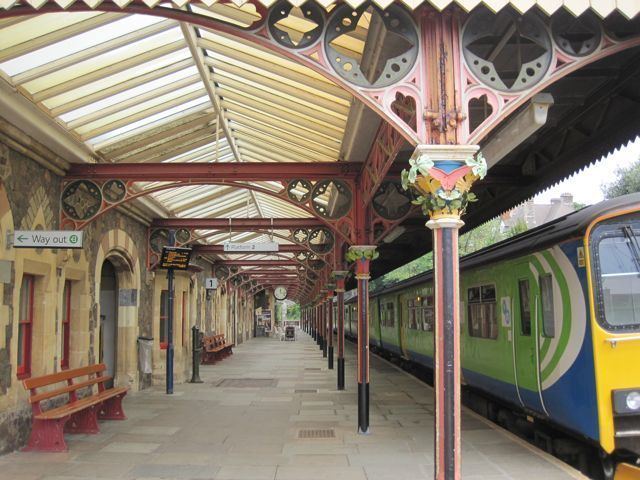Station code GMV DfT category D Opened 1860 | Grid reference SO783457 Managed by London Midland 2011/12 0.502 million Number of platforms 2 | |
 | ||
Address Malvern WR14 3AU, United Kingdom Similar Malvern Link railway st, Worcester Shrub Hill railway st, Worcester Foregate Street rail, Worcestershire Beacon, Herefordshire Beacon | ||
Great malvern railway station 14 08 14
Great Malvern railway station is one of two stations serving the town of Malvern, Worcestershire (the other being Malvern Link station) on the Hereford to Worcester section of the Cotswold Line. It is situated downhill from the centre of Great Malvern and near to Barnards Green. The station retains most of its original Victorian station design by the architect Edmund Wallace Elmslie and is a Grade II listed building.
Contents
- Great malvern railway station 14 08 14
- Great malvern railway station 23 07 16
- History
- Architecture
- Floral capitals to canopy columns
- The Worm access to Imperial Hotel
- Services
- Facilities
- References
Great malvern railway station 23 07 16
History
Great Malvern station was opened by the Worcester & Hereford Railway in 1860 and the present buildings by architect Edmund Wallace Elmslie were completed in 1862. It was later absorbed by the Great Western Railway.
Lady Emily Foley was a key sponsor of the building of Great Malvern station. She had a waiting room made for her exclusive use at Great Malvern Station, which is now ‘Lady Foley's Tea Room’, where she would wait for her train.
The station celebrated its 150th birthday on 23 May 2010 with the unveiling of a plaque and a special train. An additional part of this celebration was the reinstatement of some of the highly decorated lighting columns around the cab road at the front of the station.
Architecture
The buildings are in local Malvern Rag stone and follow a French Gothic theme.
Floral capitals to canopy columns
A particular feature of the station are the deep canopies which are supported by elaborate, cast-iron girders, which are in turn supported by columns with elaborate capitals. These capitals are decorated with high relief mouldings depicting different arrangements of flowers and foliage. The sculptor William Forsyth was employed to work on the buildings and designed the metal capitals of the columns which support the canopies above both platforms of the station.
The Worm access to Imperial Hotel
At the end of Platform 2 is the entrance to the Worm, an enclosed passageway which leads under Avenue Road into the former Imperial Hotel (now Malvern St James). It formed a private pedestrian access and is believed to be the only structure of its kind in the country. Although in need of extensive restoration and generally not open to the public, the Worm is itself Grade II listed.
Services
The station is served by two train operating companies: London Midland (who manage the station) and Great Western Railway. London Midland operate services to Birmingham New Street via Worcester and Hereford every hour and also some services to Birmingham Snow Hill via Kidderminster and Stourbridge Junction. A number of services to/from Shrub Hill and Birmingham start or terminate here.
Great Western Railway operate a roughly hourly service to London Paddington via the Cotswold Line and Oxford (some of which run to/from Hereford) and every two hours (except Sundays) to Bristol Temple Meads via Gloucester. Many Bristol services continue onwards to Westbury & Weymouth, with one through service to & from Brighton. Those services (including all from Bristol) that terminate here run empty to Malvern Wells to reverse, then return to the station to take up their next scheduled working.
There was previously a branch line to Ashchurch via Upton-on-Severn & Tewkesbury. Operated by the Midland Railway, it was closed in 1952.
Facilities
There is a ticket office and an award-winning café which opened in 1984, named 'Lady Foley's Tea Room', after Lady Emily Foley, on the east platform.
